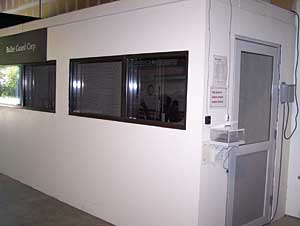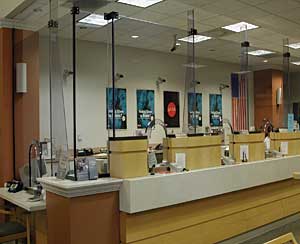Designing Bullet Resistant Protection Panel Systems: Capture More than the Imagination
Opaque applications are effective in areas such as surrounding storage cabinetry, incorporated low wall partitions, and areas below counters. Susan Oldroyd, AIA, Ross Drulis Cusenbery Architecture in Sonoma, CA, a court design expert knows, " High security court room spectator areas on first impression, convey the sense of security through the details of the interior finishes and in the hierarchy of the seating arranged for proceedings of the court. Security design is in opaque barriers behind wall paneling, and within the bench itself." Designers specify panels that manufacturers have tested both individually and mocked up in assemblies or systems made with rated ballistic resistant materials. Manufacturers complying with these criteria create an in-house sub-set of standards, which offer added protection in barrier designs.
 |
| Manufacturers factory tested assembly booth Photo credit: Bullet Guard |
Applications are specified for many different building types from manufacturer testing information. Ballistic resistant panel systems that are designed to anticipate damage or penetration risks, effectively limit these risks. Panels have been successfully designed for the highest security levels such as drive-up teller windows, lining walls of a police station, and under the counter of courtroom judge's benches, among others.
Hardening Measures in Security Planning
‘Hardening' is the term used to literally describe placing a priority on the strength of the exterior walls of a building, and the process of increasing security of the site or a building perimeter to withstand natural disaster or attack. The use of the building or institution planning security assessment is a team approach; landscape design, architect, engineer, and security consultant. It isn't just about cameras and a security guard keeping watch over the premises. The first order of business is to set goals for the security solutions to be effective.
There is no one example of a material that can use the word proof when associated with ballistics. Bullet resistant materials were first introduced in Chicago in the nineteen twenties. Specifying bullet resistance is preferred and used today to describe bullet resistant fiberglass panels for example used to construct panels protecting the public. Bullet resistant is the terminology used by the protective armoring industry.
 |
| Polycarbonate with arched voice ports Photo credit: Bullet Guard |
There are many ballistic products available on the security market, which provide hardening measures. Some of these are ballistic barrier enclosures, custom and modular panels, courtroom shields, interior and exterior aluminum frame and wood doors, secure package pass-thru panels. Designers use interior floor layouts to design mantrap systems and controlled access entries. The architect establishes the location of drive-up window pass-thru booths, transaction and fixed window panel access points in concert with limiting overall site access, visual access while inviting public access to these areas. This is an example of how early site design strategies impact the overall building security plan to incorporate bullet resistant materials.
In a bank building for example, composite panels are chosen with range in a variety of thicknesses depending upon the desired security level or risk factor. One high-level security panel system is steel anchored bullet resistant fiberglass. This can be used in the main teller area of a bank and when combined with special exchange window panels provide a secure yet open environment for banking.









